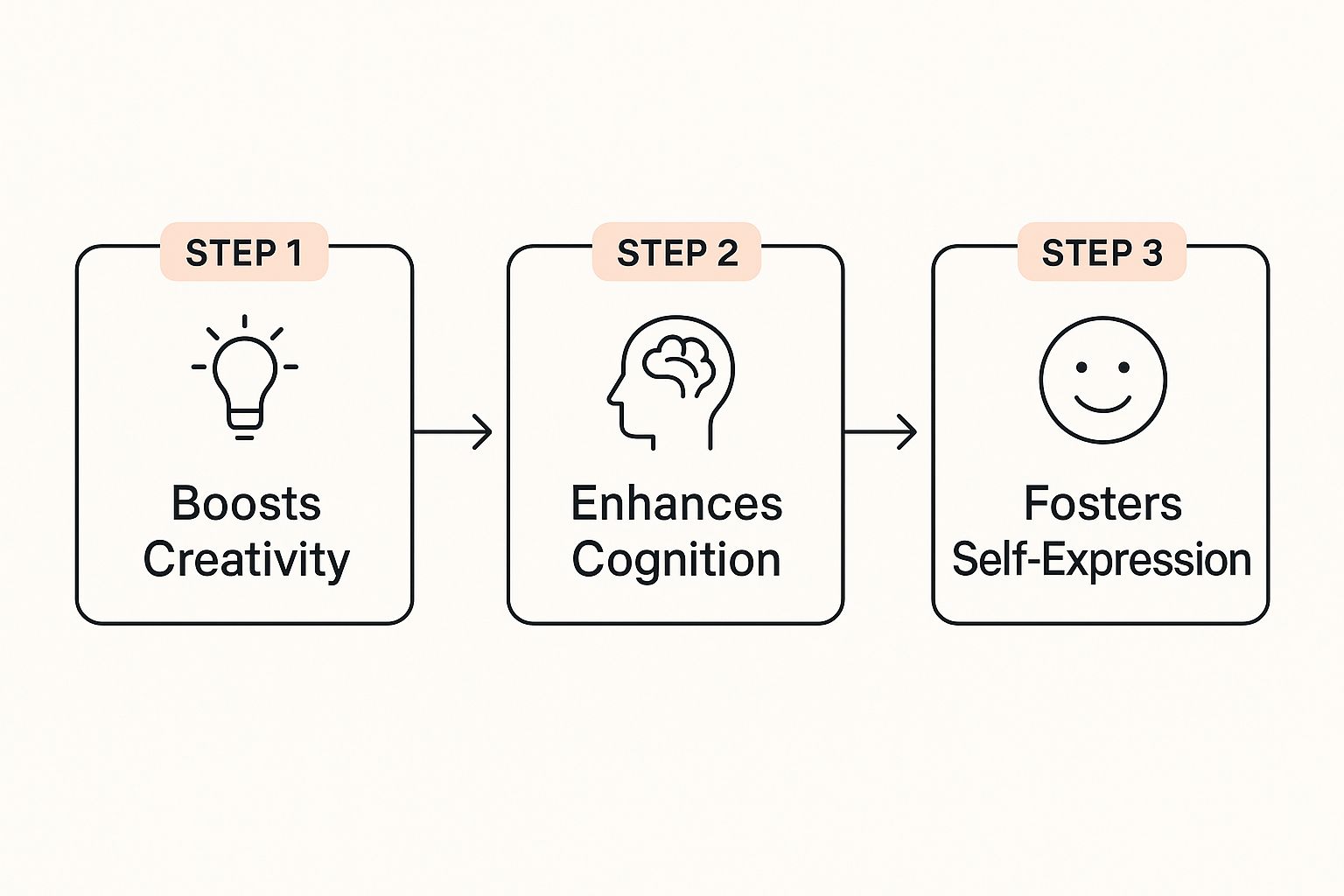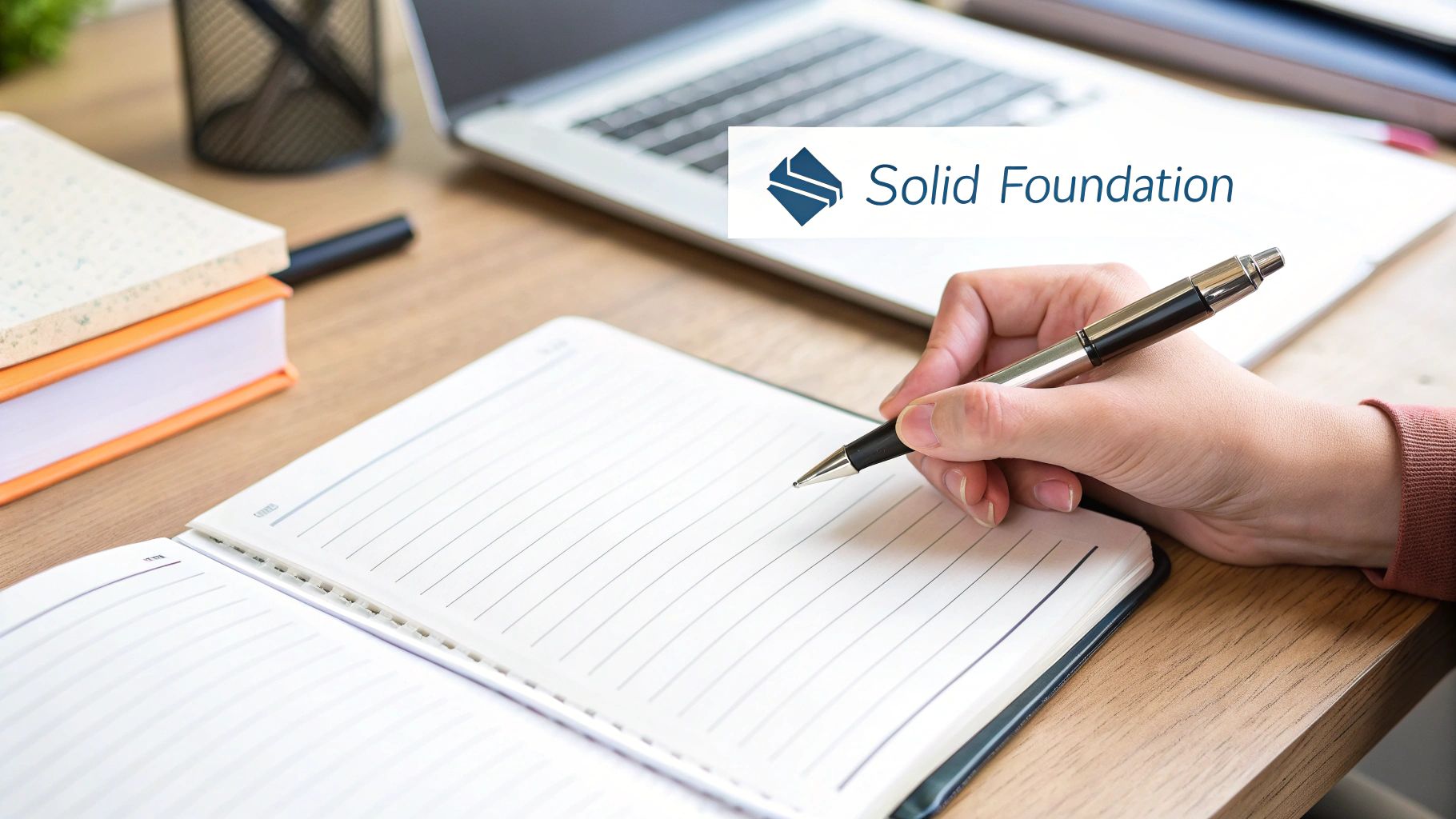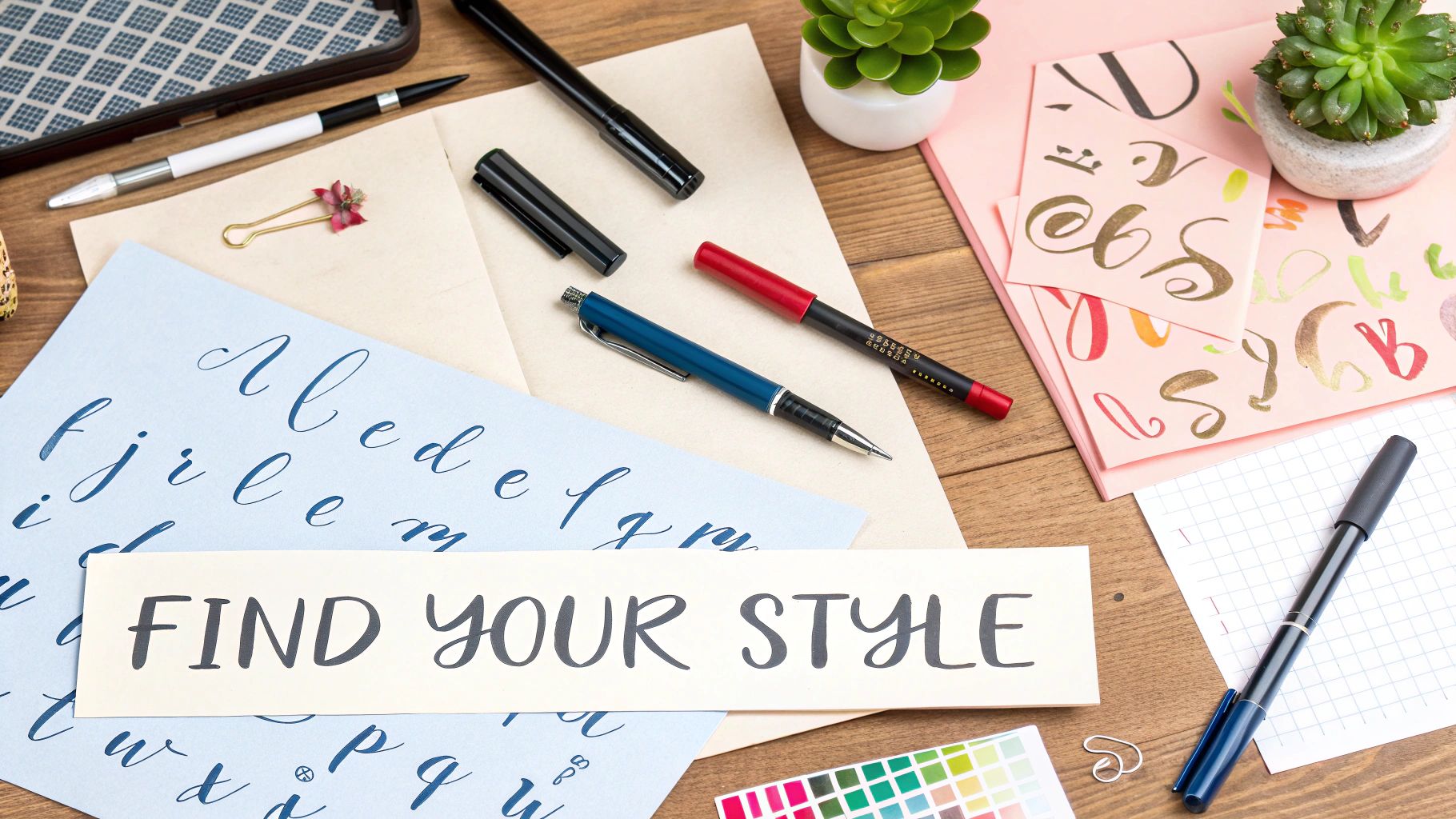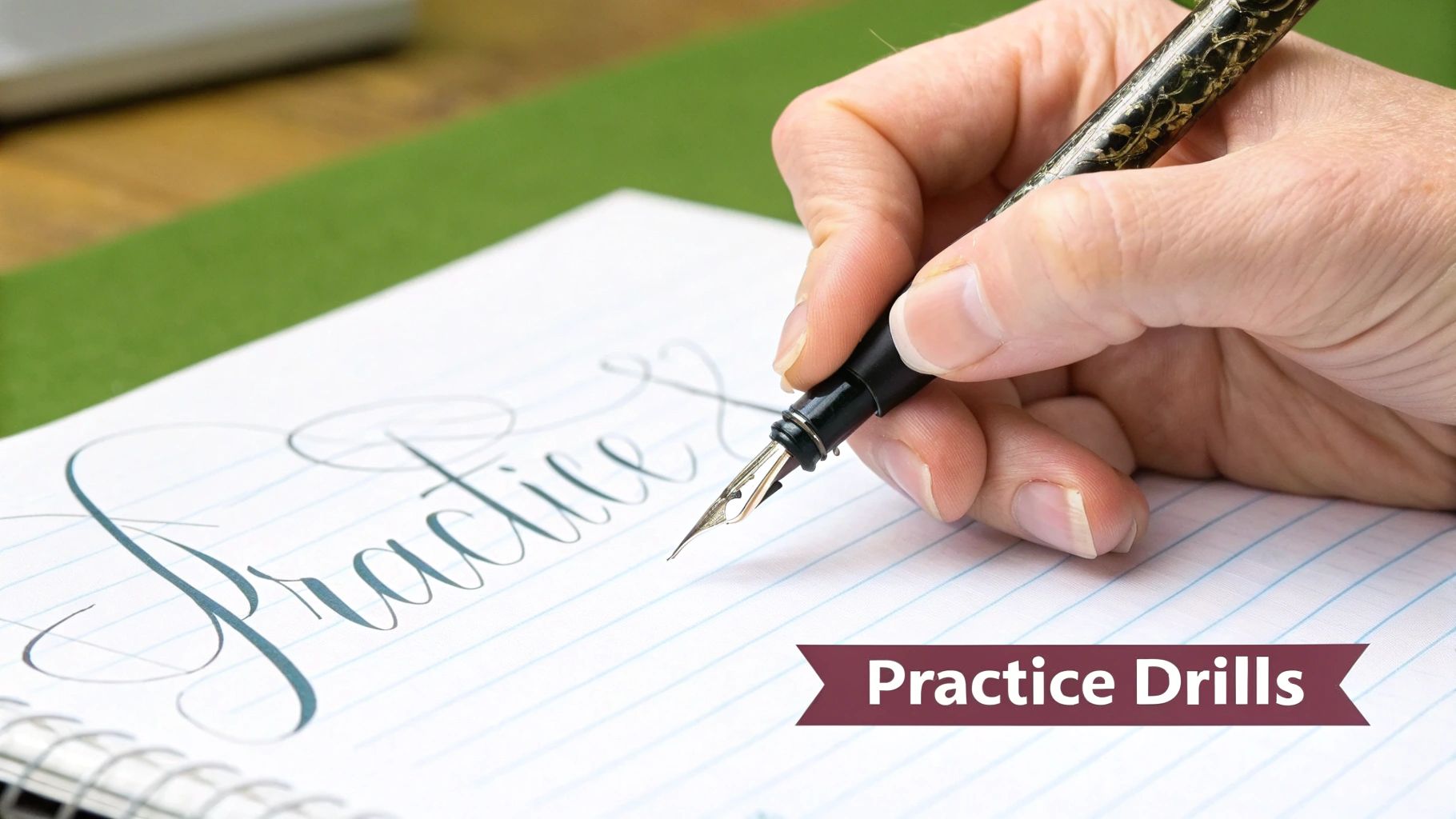Ready to transform your handwriting into something you love? It’s a beautiful journey of self-expression, and it starts with a simple, inspiring process: analyze your current script, find a style that sparks joy, and practice with intention to build new muscle memory. Let's unlock the amazing potential waiting in your hands.
Why Your Handwriting Still Matters
In a world dominated by keyboards, the act of writing by hand is a powerful form of mindfulness. It’s more than just forming letters; it’s a physical manifestation of your thoughts, connecting your mind to the page in a way typing can't replicate. This isn’t about chasing perfection—it’s about discovering a script that feels authentically and wonderfully you.
This visual guide breaks down the amazing benefits you'll get from improving your handwriting.

As you can see, this journey is about so much more than aesthetics. It's an opportunity to boost creativity, sharpen your mind, and connect with a unique part of your identity.
Reconnecting With Your Own Script
If you feel an urge to improve your handwriting, you’re in good company. In fact, a survey from Pen Heaven found that nearly one in three people are unhappy with their script. It proves that even in our digital age, this personal skill still holds deep significance.
Improving your handwriting is an act of mindfulness. It slows you down, forces you to focus, and provides a real, tangible connection to your own thoughts and creativity.
When you embrace this process, you’re not just learning a new skill; you’re giving yourself a rewarding activity that sharpens your mind. Rediscovering the pleasure of writing can bring a surprising sense of calm and accomplishment into your day.
Build a Solid Handwriting Foundation

Before you can create a beautiful, flowing script, you must get the basics right. Think of it like a musician mastering scales before playing a symphony. This first step is about creating the right physical environment to turn conscious effort into natural, subconscious skill. Your journey to better handwriting begins not with the letters, but with your body.
Action Point: Master Your Posture and Grip
How you sit and hold your pen dramatically impacts your control and comfort, preventing the hand cramps many of us remember from long writing sessions.
- Sit Tall: Sit up straight with both feet flat on the floor and your back supported. This simple adjustment frees your entire arm to move from the shoulder—the secret to smooth, graceful lines.
- Relax Your Grip: Many of us hold our pens in a death grip, leading to fatigue. Instead, hold it lightly between your thumb and index finger, letting it rest gently on your middle finger. Your hand should feel relaxed, not tense.
Key Takeaway: Think of your entire arm as your writing tool, from shoulder to fingertip. A tight grip restricts movement and creates choppy letters. A light, relaxed touch is everything.
Action Point: Choose Your Tools Wisely
The right tools can make all the difference. You don’t need anything expensive, but a pen that feels good in your hand is a game-changer. The best ones glide across the page without much pressure, which is why finding the perfect pen for your journal can elevate your practice.
Paper matters, too. A smooth, high-quality paper reduces friction and makes forming fluid strokes easier. For practice, a simple lined notebook is perfect for keeping your sizing and spacing consistent.
To help you remember these key building blocks, here’s a quick-reference table.
Core Penmanship Fundamentals
This table breaks down the essentials for building a strong handwriting foundation.
| Fundamental Element | Why It Matters | Quick Tip |
|---|---|---|
| Proper Posture | Enables free arm movement, preventing strain and improving endurance. | Sit with your back straight and both feet flat on the floor. |
| Relaxed Grip | Prevents hand fatigue and allows for fluid, controlled strokes. | Hold the pen lightly; don't squeeze it. Let it rest on your middle finger. |
| Arm Movement | Creates smoother, more consistent lines than just using your wrist. | Practice drawing large circles and lines, moving from your shoulder. |
| Right Tools | A good pen and paper reduce friction and make writing feel effortless. | Choose a pen that flows easily and paper that feels smooth to the touch. |
Nailing these core mechanics sets the stage for a real transformation. With a solid foundation in posture, grip, and tools, you’re ready to start shaping beautiful letters and developing a style you truly love.
Discover Your Personal Handwriting Style

Now that your foundation is solid, the real fun begins. This is where we move beyond mechanics and explore the artistry of penmanship. Your handwriting is an extension of your personality, so the goal isn't to perfectly copy someone else's script. It’s about discovering a style that feels authentically you.
Action Point: Curate and Deconstruct
Think of yourself as a handwriting curator. Start by gathering inspiration—the elegant loops in old letters, the clean lines of an architect's print, or a stylish font you saw online. Create a small collection of scripts you find beautiful.
Once you have your inspiration, break down the letters into their basic parts. Are the lines sharp and angular or soft and rounded? Do the letters connect smoothly, or are they detached? You’re simply borrowing elements that resonate with you and weaving them into your own script.
The most beautiful handwriting styles are not rigid copies. They are personal expressions that combine elements of structure, rhythm, and individual flair into something entirely new.
To put this into practice, start small. Pick a single letter you want to change—like your 'a' or 'g'—and focus only on that. Practice writing it over and over, experimenting with the new elements you’ve admired.
Here are a few ideas to get you started:
- Loops: Try making the loops on letters like 'l' and 'h' taller and narrower for an elegant look.
- Connections: Play with how your cursive letters link together. Do they connect at the bottom, in the middle, or near the top?
- Flourishes: Add a subtle flick to the end of your 't' or a more dramatic tail to your 'y'. Small details make a big impact.
By focusing on one letter at a time, you build new muscle memory without feeling overwhelmed. This mindful, deliberate practice is what turns conscious effort into an effortless, beautiful script that is uniquely yours.
Practice Drills That Build Muscle Memory

Lasting change in your handwriting comes down to one thing: consistent, mindful repetition. Like an athlete training specific muscles, you have to give your hand and arm a structured workout. Targeted drills are your secret weapon. They transform hesitant strokes into confident, flowing lines by building new muscle memory.
Action Point: Embrace Deliberate Practice
The key to making every session count is deliberate practice. This means you stop mindlessly filling pages and start focusing intensely on improving one specific thing at a time. Maybe today, you concentrate only on making your downstrokes perfectly parallel. This focused approach turns simple repetition into a powerful tool for growth.
Your mind and muscles are learning a new dance together. Be patient and intentional with each movement. Soon, the steps will become second nature, flowing effortlessly onto the page.
Essential Handwriting Drills
Ready to start? Begin with these foundational exercises for 5-10 minutes before you start writing words.
- Upstrokes and Downstrokes: Fill a few lines with alternating light upstrokes and slightly firmer downstrokes. The goal is to keep them parallel and evenly spaced.
- Loops and Ovals: Practice making continuous, connected loops (like a cursive 'l') and ovals (like the letter 'o'). Concentrate on making their size and slant uniform to build rhythm.
- Letter Linking: For cursive, try connecting repeating letters like 'un-un-un' or 'om-om-om'. This perfects the tricky transitions between shapes for a smooth flow.
This foundational work is crucial. In fact, research on handwriting difficulties among school-going children shows that around 34% of students have non-proficient skills, highlighting why dedicated practice matters.
Once you feel warmed up, move on to writing pangrams—sentences that contain every letter, like "The quick brown fox jumps over the lazy dog." This forces you to practice every letter in context, solidifying the skills you just honed.
Strengthen Your Brain-Hand Connection
Changing your handwriting is so much more than a physical exercise—it's a powerful cognitive workout that reshapes the neural pathways in your brain. Every time you practice forming a letter, you're strengthening the intricate connection between your mind and your hand.
This isn’t just a feel-good idea; there’s solid science behind it. Neuroimaging studies show that the physical act of writing by hand activates parts of the brain related to thinking, language, and working memory. This focused engagement has been shown to boost letter recognition and improve recall.
When you practice, you’re not just cleaning up your script. You’re actively engaging your brain, enhancing your memory, and sharpening your focus. This turns practice from a chore into a deeply beneficial mental exercise.
A True Workout for Your Brain
Understanding this brain-hand link is a huge motivator. Research shows that as adults practice new letter shapes, their brains develop specialized pathways for them—something that doesn't happen when just typing. Your brain literally adapts and grows with every stroke.
This process demands serious coordination between your eyes and hand. To improve control and consistency, it’s worth exploring specific training, like these 7 Essential Eye Hand Coordination Exercises, to enhance the precision of your movements.
See each practice session as a form of meditation. As you focus on the shape of a letter or the flow of a word, you’re training your brain to stay present. You’re not just learning to change your penmanship; you’re building a more focused, resilient, and connected mind.
A Few Common Questions About Improving Your Penmanship
Embarking on this journey to transform your handwriting often brings up a few questions. Let's tackle the most common ones so you can stay inspired and move forward with confidence.
How Long Does This Actually Take?
The timeline is completely up to you and your consistency. With 15-20 minutes of focused practice each day, you will almost certainly see a real improvement in control and confidence within a few weeks. However, building a new, subconscious style—one that flows naturally without thinking—takes longer. To truly lock in that muscle memory, expect several months of dedication. Remember, this is a marathon of mindfulness, not a sprint.
Do I Really Need Fancy or Expensive Tools?
Absolutely not. While a beautiful pen or high-quality paper can make practice feel more special, they aren't essential for progress. The best tool is one that feels comfortable and lets you write without much pressure.
- Go for comfort: Choose a pen that fits your hand and glides smoothly.
- Keep it simple: A standard lined notebook is all you need to start.
Focus on your technique first and the tools second. For more inspiration, this detailed guide on improving your handwriting has some wonderful tips.
What If My Hand Always Starts to Cramp?
Hand cramping is almost always a signal from your body. It usually points to one of two things: you're gripping the pen too tightly or your posture needs adjustment.
Key Insight: Your pen should feel like it's resting in your hand, not like you're squeezing the life out of it. The secret to writing for hours without getting tired is a light, tension-free grip.
Consciously relax your entire arm, from your shoulder down to your fingertips. Sit up straight, take stretching breaks, and let the pen do the work. It’s a small change that makes a world of difference, turning practice from a chore into a pleasure.
At Mesmos, we believe in the power of putting pen to paper to foster mindfulness and self-expression. Discover our collection of beautifully designed pens and stationery to inspire your writing journey at https://mesmos.co.
